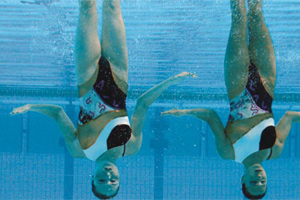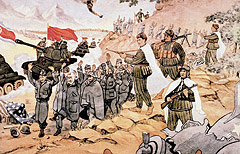Although our lungs have the right structure to dilate and contract, depending on the entry or exit of air, they need the joint assistance of other organs and tissues that ease the true pumping system that enables us to breathe. The muscles involved in respiration are very important in order to perform basic, but vital movements of inspiration and expiration.
The diaphragm
It is the main muscle involved in the respiratory process. It has a shape similar to that of a parachute and takes up a large part of the surface of the thorax. It separates this last one from the abdomen and is perforated by a series of orifices that ease the advance of some structures. Among them we highlight the esophagus (esophageal orifice) and the aorta (aortic orifice).
This important muscle (the flattest of our body) is made up of three groups of muscle fibers that crisscross. Their edges are connected to the spine by the back part; to the inferior ribs by the sides and in the front, with the distal part of the sternum, forming a real dome that houses important organs located in this area, like the liver, stomach and spleen.
It is asymmetrical -it has more of an extension in the front than in the back- because the ribs of the anterior part of our body are more elevated. It has several parts: a vertebral part (known as the pillars of the diaphragm), a lumbar part (fibers that go from the first lumbar vertebra up to the twelfth rib), a side (costal) part (from the seventh rib to the twelfth) and the sternal fibers (located in the inferior part of the sternum)
Intercostal muscles
Another series of muscles, housed in the thorax, they also participate in the respiratory process. They are the intercostal muscles, that enable the movement of the ribs up, down and outwards, expanding the chest, pulling the lungs forward, thus increasing their volume.
Lets imagine our thorax is a real cage. The bars could be the ribs, each one located next to the other. The empty spaces between each of them (intercostal spaces) are used by flat muscles, that form a real mesh in the internal area of our trunk.
The external intercostal muscles participate in inspiration and the internal, in expiration. Their joint action is capable of stabilizing the size reached by the intercostal space when faced with any movement, especially during the action of the diaphragm.
Inspiration and expiration
The constant renewal of oxygen and the exit of carbon dioxide demands a specific organization to allow the entry (inspiration) and expulsion (expiration) of air. As the lungs do no not have a musculature of their own to perform these processes, the joint action of the intercostal muscles and diaphragm enable the gas exchange. They increase or decrease thoracic capacity, depending on the requirements of our body, making the capacity of the pulmonary ligaments greater or smaller.
When we inhale, the diaphragm contracts, radically changing the physiognomy and capacity of the thoracic cage. When we inhale air from the outside, the contraction of the diaphragm compresses the abdominal viscera and enables a considerable increase of the space of the thorax, which grants the necessary surface for our lungs to inflate with the inhaled air. The intercostal muscles also contribute in this task, which contract and make the ribs move up and outwards, slightly increasing the capacity of the thoracic cage.
When we expulse air from our lungs (expiration), the muscles involved relax. The diaphragm recovers its parachute shape, the ribs move down (gravity also has to do with this) and in, contracting the lungs and recovering the thoracic cavity’s initial space. The flow of air will finally return towards the exterior and will be exhaled by the superior airways.
Nerve control of respiration
Like most of the processes that take place in our body, respiration is controlled by our central computer: the brain. In a true chain reaction, the human body is capable of coordinating all of the structures and receptors that adjust ventilation to the physical needs of every moment, be it in states of rest or movement.
Diverse basic and involuntary functions of our body are controlled from the cerebral trunk, among them, respiration. The rachidian bulb is the specific segment in charge of determining the ventilation rate. Its action is hardly perceptible because, as it is an automatic process, we are not aware that we are performing it.
Just think how many times you have inhaled and exhaled as you’ve read this supplement. Surely, you don’t know, because breathing is obvious for you.
In order to facilitate an adequate respiratory response, our body also counts with a series of receptors that are stimulated before foreign substances, respiratory afflictions and abnormal concentrations of carbon dioxide, among other causes.
The receptors located in the lung are called mechanoreceptors. Their function is to gather the received information and transmit it to the respiratory center through the vagus nerve (in charge of visceral control). They are divided into three types: distension, irritation and vascular or juxtacapillary receptors.
The distension ones are those that respond the slowest and their stimulation causes the elongation of the smooth muscles of the airways during inspiration.
Meanwhile, the irritation receptors are quickly stimulated and have more of a defensive end; they are activated by irritating gases, allergic reactions, congestion and pulmonary embolisms, among other factors, generating responses like coughing.
Finally, the vascular or juxtacapillary receptors are located in the space between the alveoli and the capillaries, becoming stimulated by processes that involve this area (interstitial edema or the action of chemical irritants, among others).
Gaseous concentrations
Our body also reacts to the changes in the normal concentrations of gases involved in the respiratory exchange.In order to do so, it counts with chemoreceptors for oxygen as well as for carbon dioxide, mostly located in some areas of the carotid artery and the aortic artery.The receptors that react to the presence of carbon dioxide are split into central (cells located in the rachidian bulb) and peripheral (present in the carotid artery and the aorta); while the receptors in charge of maintaining a normal level of oxygenation are only peripheral and are located in the carotid bifurcation.








 Termina la Guerra de Corea
Termina la Guerra de Corea